And if you type ``typical Canadian things´´ into the internet, maple syrup should show up near the top. Yes, maple syrup is good, sweet, not full of chemicals, all natural, fresh from the trees (well almost) and Canadian. A lot of people we know make maple syrup. But how do you make maple syrup? Do you take the leaves of a maple tree, put it in water and add sugar? Do you take the roots of a maple tree, make something like root beer and then concentrate it? NO!!! Every spring the sap in the tree runs up and down the tree, transporting nutrients, minerals and sugar. What you have to do is drill a hole in to the tree, put a tap in it and let the sap drip out. Then you take your collected sap, put it over a fire and concentrate it.
 |
| Collecting sap in the sugar bush at Hollanbec Farm. |
 |
| Here friends at Hollanbec Farm are boiling down the sap! This process lasts quite a few hours. |
 |
| Their finished product. Yum! |
So why don´t you make maple syrup in other countries? Well, there are a lot of different maples out there. Theoretically, you could make syrup with the sap from EVERY TREE!!! So you could get birch syrup, white maple syrup, hornbeam maple syrup, silver maple syrup, red maple syrup and the possibilities are (almost) endless. But why don´t you make maple syrup in other countries?? There is one type of maple tree used to make maple syrup. ``The sugar maple´´. The sugar maple contains 2% sugar in the sap. All other maples contain 1%. Some other countries do not have sugar maples at all. Did you know that the earliest recorded descriptions of the Native American method of extracting a syrup from maple trees was published in the ``Philosophical Transactions of the Royal Society´´, London, England, in 1684?
So, we want to try and make maple syrup now that we are in Canada. One day we drove up to our property north of Lanark to tap some trees. The road is a dirt road, and it doesn't get plowed in the winter. There are a lot of hills there, one as high as a mountain (well at least for the standards of the area 😉). The road was pure ice. We tried to get up that hill. We almost made it. Only a few more meters. But then the car stopped and we slid back down again. It wasn´t that fast. Because we almost made it we decided to try and get up the hill again. We went up, we were almost at the top, again, but then the car stopped, and we slid back down. Again. This time faster. The only thing preventing us from sliding into the ditch were tire tracks in the ice made by logging trucks. It was scary. So we decided NOT to try that again. We did not have that much to carry so we walked in the rest of the way. When we arrived Cathy (This is Jonathan writing), aka my Mum, noticed that she forgot the soup stock for our lunch. That´s OK. We won´t starve.
 |
| Ice makes a great slide! |
One of the first things we did was find the sugar maple trees. My dad had a handbook on trees with the shape of the leaves. Did you know that every maple has a different leaf? This is the leaf of the sugar maple:
Sugar Maple Leaf
|
It is early spring. There aren't any new leaves on the trees. So, how do you know if something is a sugar maple or something else? There are a few characteristics:
- When growing in the forest it develops a trunk free of branches for two-thirds or more of its height.
- The leaves are three lobed with only a few irregular, wavy teeth.
- The bark is grey, divided in to long , vertical, firm, irregular strips.
So, there is bark, and there are branches, but where are the leaves? As most of you probably know (but only probably 😉😉😉) all the leaves of deciduous trees (so, not evergreen) fall off in the autumn. Almost all of the time the leaves are under the tree that they fell from. Once we came to a tree with five different types of leaves under it, so we left it. It didn´t take us long to find a few trees. When we found the trees, we drilled a hole, stuck a tap in and waited. And we waited and waited. No sap came dripping out of the first tree. Or the second. Or the third. After I do not know how many trees there was sap dripping out of the tap. Now, we cannot drive up to Lanark every day to pour the sap in to another bucket and keep collecting. Instead we bought big water containers called Aqua Tainers. With some tubing we directed the sap into these Aqua Tainers and piled snow around them. This will help to preserve the quality of the sap so we can wait a week before we come back. We tapped 7 trees. That is not a lot. We know that. But it is a good start if you are doing it for your first time. Before we left we were able to taste a bit of sap which the one tree had already produced. It tastes like water with a little sweetness. We will go back soon to boil it down. More information next time. I hope you liked this blog and will read the next one soon.
Take care!!!
Jonathan
Jonathan



1 comment:
Coole Sache.
Ich habe gerade Farmer Boy ( Wilder) gelesen. Da war das auch beschrieben. Aber ich wusste nicht, dass nur 2% Zucker im AHORNSAFT sind.
Viel Spaß beim Einkochen.
Liebe Grüsse aus dem österreichischen Frühling.
Gudrun
Post a Comment